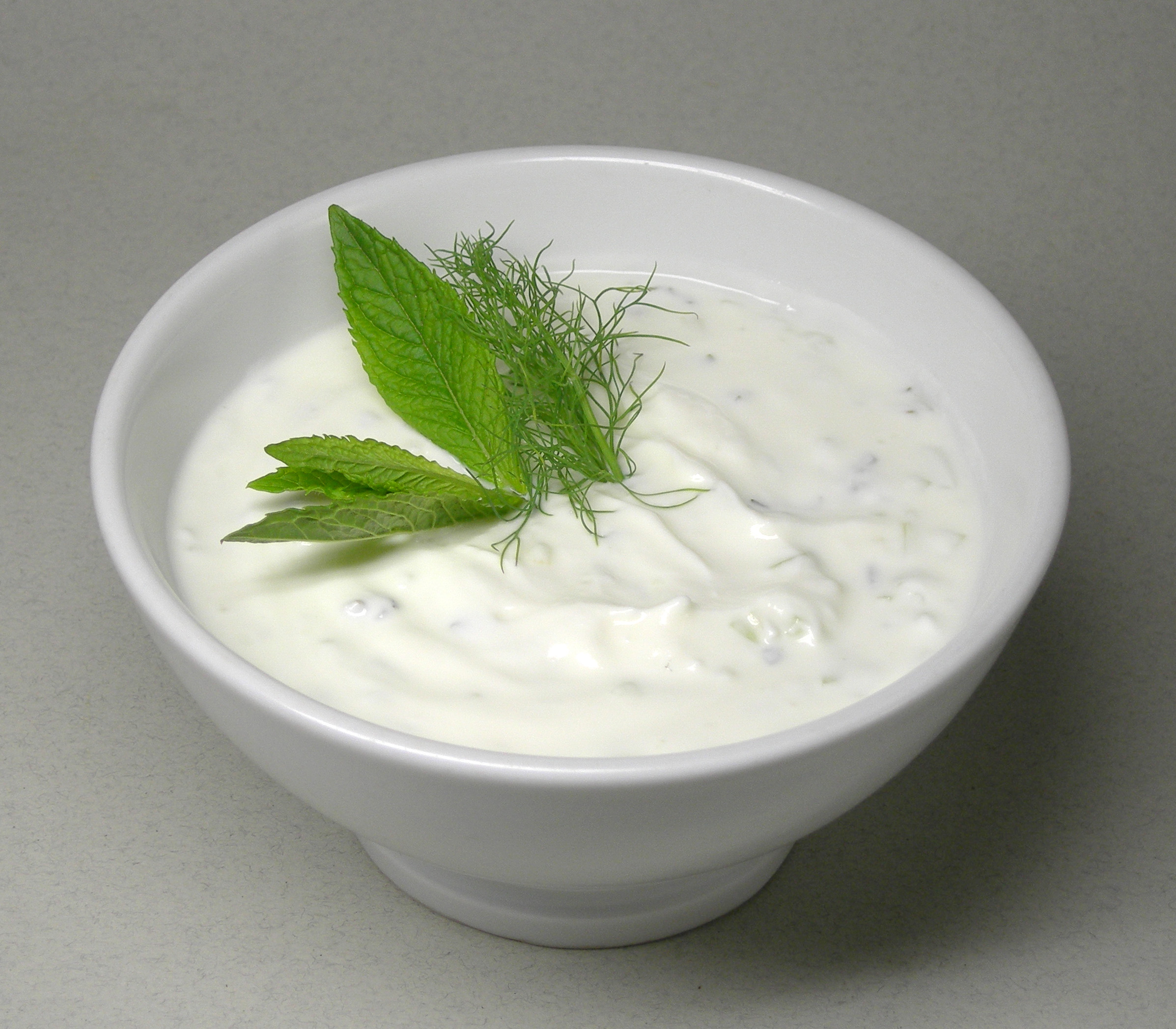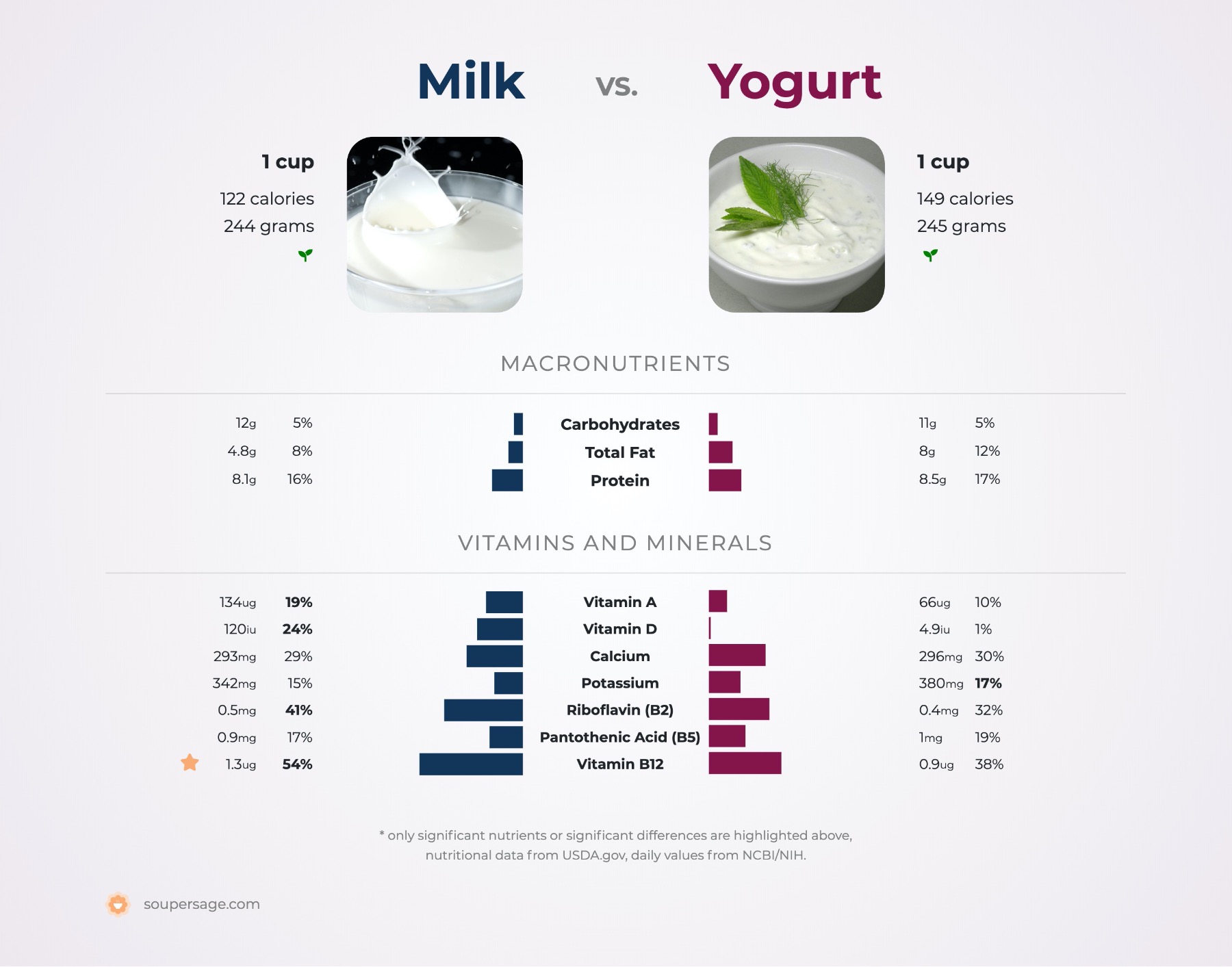Milk vs. Yogurt
Nutrition comparison of Milk and Yogurt
Ever wonder how your favorite foods stack up against each other in terms of nutrition?
We compared the nutritional contents of
milk
versus
yogurt
(100g each)
below using 2020 USDA and NIH data[1].
For a quick recap of significant nutrients and differences in milk and yogurt:
- Both milk and yogurt are high in calcium.
USDA sources for nutritional information: Milk (Milk, reduced fat, fluid, 2% milkfat, with added vitamin A and vitamin D) and Yogurt (Yogurt, plain, whole milk) . Have a correction or suggestions? Shoot us an email.
Calories and Carbs
calories
Milk and yogurt contain similar amounts of calories - milk has 50 calories per 100 grams and yogurt has 61 calories.
For macronutrient ratios, milk is heavier in protein, heavier in carbs and lighter in fat compared to yogurt per calorie. Milk has a macronutrient ratio of 27:38:35 and for yogurt, 22:30:48 for protein, carbohydrates and fat from calories.
Macro Ratios from Calories:
| Milk | Yogurt | |
|---|---|---|
| Protein | 27% | 22% |
| Carbohydrates | 38% | 30% |
| Fat | 35% | 48% |
| Alcohol | ~ | ~ |
carbohydrates
Both milk and yogurt are low in carbohydrates - milk has 4.8g of total carbs per 100 grams and yogurt has 4.7g of carbohydrates.
The carbs in milk and yogurt are both made of 100% sugar.
sugar
Milk and yogurt contain similar amounts of sugar - milk has 5.1g of sugar per 100 grams and yogurt has 4.7g of sugar.
Protein
protein
Milk and yogurt contain similar amounts of protein - milk has 3.3g of protein per 100 grams and yogurt has 3.5g of protein.
Fat
saturated fat
Milk and yogurt contain similar amounts of saturated fat - milk has 1.3g of saturated fat per 100 grams and yogurt has 2.1g of saturated fat.
trans fat
Both milk and yogurt are low in trans fat - milk has 0.09g of trans fat per 100 grams and yogurt does not contain significant amounts.
cholesterol
Milk and yogurt contain similar amounts of cholesterol - milk has 8mg of cholesterol per 100 grams and yogurt has 13mg of cholesterol.
Vitamins
Vitamin C
Milk and yogurt contain similar amounts of Vitamin C - milk has 0.2mg of Vitamin C per 100 grams and yogurt has 0.5mg of Vitamin C.
Vitamin A
Milk has 104% more Vitamin A than yogurt - milk has 55ug of Vitamin A per 100 grams and yogurt has 27ug of Vitamin A.
Vitamin D
Milk has 23 times more Vitamin D than yogurt - milk has 49iu of Vitamin D per 100 grams and yogurt has 2iu of Vitamin D.
Vitamin E
Milk and yogurt contain similar amounts of Vitamin E - milk has 0.03mg of Vitamin E per 100 grams and yogurt has 0.06mg of Vitamin E.
Vitamin K
Milk and yogurt contain similar amounts of Vitamin K - milk has 0.2ug of Vitamin K per 100 grams and yogurt has 0.2ug of Vitamin K.
The B Vitamins
Both milk and yogurt contain significant amounts of thiamin, riboflavin, niacin, pantothenic acid, Vitamin B6, folate and Vitamin B12.
| Milk | Yogurt | |
|---|---|---|
| Thiamin | 0.039 MG | 0.029 MG |
| Riboflavin | 0.185 MG | 0.142 MG |
| Niacin | 0.092 MG | 0.075 MG |
| Pantothenic acid | 0.356 MG | 0.389 MG |
| Vitamin B6 | 0.038 MG | 0.032 MG |
| Folate | 5 UG | 7 UG |
| Vitamin B12 | 0.53 UG | 0.37 UG |
Minerals
calcium
Both milk and yogurt are high in calcium. Milk is very similar to milk for calcium - milk has 120mg of calcium per 100 grams and yogurt has 121mg of calcium.
iron
Milk and yogurt contain similar amounts of iron - milk has 0.02mg of iron per 100 grams and yogurt has 0.05mg of iron.
potassium
Milk and yogurt contain similar amounts of potassium - milk has 140mg of potassium per 100 grams and yogurt has 155mg of potassium.
Antioxidants and Phytonutrients
carotenoids
Carotenoids are micronutrients commonly found in plants and some animal products. An example is beta-carotene, the notable carotenoid which is a popular source of Vitamin A.[4][5]
For specific types of carotenoids, both milk and yogurt contain small amounts of beta-carotene.
| Milk | Yogurt | |
|---|---|---|
| beta-carotene | 4 UG | 5 UG |
Omega-3 and Omega-6
omega 3s
For omega-3 fatty acids, yogurt has more alpha linoleic acid (ALA) than milk per 100 grams.
| Milk | Yogurt | |
|---|---|---|
| alpha linoleic acid | 0.008 G | 0.027 G |
| Total | 0.008 G | 0.027 G |
omega 6s
Comparing omega-6 fatty acids, both milk and yogurt contain significant amounts of linoleic acid.
| Milk | Yogurt | |
|---|---|---|
| other omega 6 | 0.004 G | ~ |
| linoleic acid | 0.062 G | 0.065 G |
| Total | 0.066 G | 0.065 G |
Customize your serving size
The comparison below is by common portions, e.g. cups, packages. You can also see a more concrete comparison by weight at equal weight (by grams) comparison.
Milk g
()
|
Daily Values (%) |
Yogurt g
()
|
|||||
|---|---|---|---|---|---|---|---|
| KCAL % |
|
5% | calories | 5% |
|
KCAL % | |
| G % |
|
5% | carbohydrates | 5% |
|
G % | |
| G % |
|
5% | dietary fiber | 5% |
|
G % | |
| G | 5% | sugar | 5% | G | |||
| G % |
|
5% | total fat | 5% |
|
G % | |
| G % |
|
5% | saturated fat | 5% |
|
G % | |
| G | 5% | monounsaturated fat | 5% | G | |||
| G | 5% | polyunsaturated fat | 5% | G | |||
| G | 5% | trans fat | 5% | G | |||
| MG | 5% | cholesterol | 5% | MG | |||
| MG % |
|
5% | sodium | 5% |
|
MG % | |
| 5% | Vitamins and Minerals | 5% | |||||
| UG % |
|
5% | Vitamin A | 5% |
|
UG % | |
| MG % |
|
5% | Vitamin C | 5% |
|
MG % | |
| IU % |
|
5% | Vitamin D | 5% |
|
IU % | |
| MG % |
|
5% | calcium | 5% |
|
MG % | |
| MG % |
|
5% | iron | 5% |
|
MG % | |
| MG % |
|
5% | magnesium | 5% |
|
MG % | |
| MG % |
|
5% | potassium | 5% |
|
MG % | |
| MG % |
|
5% | thiamin (Vit B1) | 5% |
|
MG % | |
| MG % |
|
5% | riboflavin (Vit B2) | 5% |
|
MG % | |
| MG % |
|
5% | niacin (Vit B3) | 5% |
|
MG % | |
| MG % |
|
5% | Vitamin B6 | 5% |
|
MG % | |
| MG % |
|
5% | pantothenic acid (Vit B5) | 5% |
|
MG % | |
| UG % |
|
5% | folate (Vit B9) | 5% |
|
UG % | |
| UG % |
|
5% | Vitamin B12 | 5% |
|
UG % | |
| MG % |
|
5% | Vitamin E | 5% |
|
MG % | |
| UG % |
|
5% | Vitamin K | 5% |
|
UG % | |
| G % |
|
5% | protein | 5% |
|
G % | |
| UG % |
|
5% | biotin (Vit B7) | 5% |
|
UG % | |
| MG % |
|
5% | choline | 5% |
|
MG % | |
| MG % |
|
5% | chlorine | 5% |
|
MG % | |
| UG % |
|
5% | chromium | 5% |
|
UG % | |
| MG % |
|
5% | copper | 5% |
|
MG % | |
| UG % |
|
5% | fluoride | 5% |
|
UG % | |
| UG % |
|
5% | iodine | 5% |
|
UG % | |
| MG % |
|
5% | manganese | 5% |
|
MG % | |
| UG % |
|
5% | molybdenum | 5% |
|
UG % | |
| MG % |
|
5% | phosphorus | 5% |
|
MG % | |
| UG % |
|
5% | selenium | 5% |
|
UG % | |
| MG % |
|
5% | zinc | 5% |
|
MG % | |
| G | 5% | Water | 5% | G | |||
| G | 5% | Starch | 5% | G | |||
| G | 5% | Alcohol | 5% | G | |||
FAQ
Does milk or yogurt contain more calories in 100 grams?Milk and yogurt contain similar amounts of calories - milk has 50 calories in 100g and yogurt has 61 calories.
Does milk or yogurt have more carbohydrates?
By weight, both milk and yogurt are low in carbohydrates - milk has 4.8g of carbs for 100g and yogurt has 4.7g of carbohydrates. the carbs in milk and yogurt are both made of 100% sugar.
Does milk or yogurt contain more calcium?
Both milk and yogurt are high in calcium. Milk is very similar to milk for calcium - milk has 120mg of calcium in 100 grams and yogurt has 121mg of calcium.


